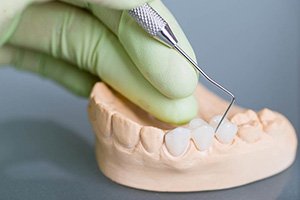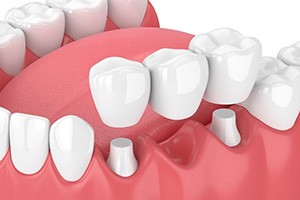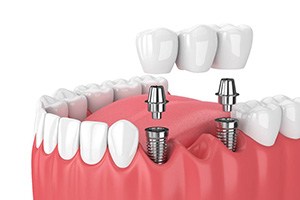Dental Bridges – Lincoln, NE
Tooth Replacement Made Simple
Sometimes, it isn’t necessary to replace the entire tooth’s structure. Maybe you only have a couple or even just one missing tooth, in which case, you can simply replace the crown portion with a dental bridge. At Williamsburg Dental, we consider your needs and goals and recommend treatment for your unique smile, and sometimes a bridge is the best way to go to replace teeth. To see if this restoration is the right choice for you, contact us for an appointment.
What is a Dental Bridge?

Bridge treatment involves the use of a prosthetic tooth or set of teeth to replace up to three missing teeth in a row. Two abutment crowns are placed on either side of the gap created by the missing teeth, and pontics (prosthetic teeth) are attached in between to span the gap. Your bridge will be meticulously crafted to blend seamlessly with the rest of your smile, matching the size, shape, and color of your natural dentition.
Types of Dental Bridges

Overall, there are two kinds of dental bridges to fill in missing teeth. During your consultation, we can discuss which option would be best for your mouth and situation.
Traditional Dental Bridge

Traditionally, a dental bridge is attached to the two healthy teeth on each side of the hole. The enamel on these abutment teeth is reduced to make room for the bridge, but they also serve as stable anchors for the restoration and enable you to complete your smile without having to get dentures. With the proper care, traditional bridges usually last up to 10 years.
Implant Bridge

Similar to the traditional version, an implant bridge has one or more false teeth in the middle, but instead of bonding to existing teeth, the bridge is fixed to two dental implants. Secured directly to the jawbone, implant bridges are much more efficient than having a single implant for each missing tooth, but they offer the same benefits, such as a strong bite, no impact on your remaining healthy teeth, and more!
The Benefits of Getting a Dental Bridge

Compared to not replacing missing teeth, getting a dental bridge offers many advantages for your smile. For example, with one or missing teeth, your remaining teeth will shift out of alignment, which means your smile will have more gaps in it. As a result, your bite will change, potentially leading to additional tooth loss. Bridges keep your teeth appropriately spaced. In addition, implant bridges specifically strengthen the jawbone, which usually weakens after tooth roots are removed, and make it possible to continue eating a healthy diet.
Dental Bridges FAQs
Here are some of the questions we get from our patients about bridges. If you have others, feel free to reach out to us and schedule a consultation!
How Long Does It Take to Get a Dental Bridge?
The timeline of your bridge treatment will depend on which type you receive. Traditional bridges require only two appointments: one to prepare the tooth and take impressions and the other for bonding the bridge into place. Note that it will take the lab a few weeks to fabricate this restoration. Implant bridges have a longer timeline because the jawbone needs several months to grow and surround the implant posts. As a result, this treatment may take anywhere between six months to a year to complete. But rest assured, the reward of having a complete smile again is well worth this investment of your time!
Does Getting a Dental Bridge Hurt?
Regardless of whether you’re receiving a traditional or implant bridge, the process may involve some discomfort, but it shouldn’t be painful. During the various procedures (implant placement or reducing anchor teeth) in our office, you will be numbed with a local anesthetic and won’t feel anything. Afterward, as the numbing subsides, you may have soreness and discomfort for a few days, but over-the-counter pain medication should be able to control your symptoms.
Do Bridges Require Special Maintenance?
Unlike dentures, dental bridges do not come with a special set of maintenance instructions. You do have to care for them, but that care is the same as what you do for natural teeth. You must brush and floss your teeth, including your bridge, every day. You also need to keep coming to our practice for checkups and cleanings at least every six months. We can closely watch your restoration and make sure it remains in good condition. As soon as it shows signs of excessive wear and tear, we can replace it before it fails on you.
Will My Bridge Look Fake?
As long as you take proper care of your dental bridge, it should look completely natural. In fact, untrained eyes may not be able to tell you have a bridge at all! These prosthetic teeth are fabricated in a dental lab using impressions taken of your teeth. Using tooth-colored materials, the technicians craft a custom prosthetic specifically for your mouth. In other words, your bridge will look like it was meant to be in your unique smile.
